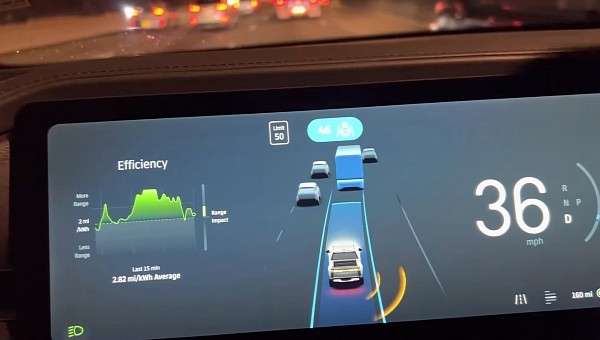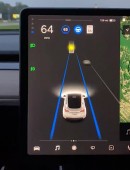Driver-assist features have been around for years, but they have not gotten people’s attention until Tesla decided to call it “Autopilot.” Nevertheless, there are new kids in town, and Rivian’s Highway Assist is one of them. Thanks to an owner who drives a Tesla Model 3 and a Rivian R1S, we know how the Rivian Highway Assist compares to Tesla Autopilot.
Naming their driver-assist suite “Autopilot” was a tongue-in-cheek move from Tesla and Elon Musk. It certainly helped advertise the feature to people not entirely used to such systems, but it also led to confusion and, ultimately, regulator scrutiny. At this point, the jury’s still out on whether the Autopilot name helped or hurt Tesla’s business, considering all the flack the company had to take. It suffices to say that some people took its name a little too seriously, leaving it to the car to do much of the driving.
This has led to some unintended consequences, including some high-profile crashes. After all, engaging the Autopilot should mean there’s an autopilot in charge like it is in a commercial aircraft. Few people grasped the idea that roads on the ground have curves and intersections and there’s traffic to keep an eye on, unlike the sky highways, where keeping the plane steady on a straight line is all that counts. This confusion is still haunting Tesla, although it has doubled down with the Full Self-Driving, an advanced version of the Autopilot that still cannot drive the car itself.
The Autopilot combines two essential functionalities, adaptive cruise control (ACC) and lane centering, to make it easier for drivers in boring highway traffic. Rivian, for its part, offers similar functionalities called Driver+ (the ACC part) and Highway Assist (when combined with lane centering). Both engage in a similar way, with one or two clicks down on the drive stalk. But this is pretty much where similarities end for the two competing systems. User stynes of the Rivian Forums has both a Tesla Model 3 and a Rivian R1S, so he explains how they differ and which one is better.
According to his post in the forums, the Tesla Autopilot has a big advantage because it is available virtually on every road. Rivian’s Highway Assist, on the other hand, can handle most of the interstates and pretty much nothing else. There are also differences in how the two systems handle driving while engaged, and here, too, Tesla Autopilot beats Rivian’s Highway Assist. That’s because the Rivian HA frequently disengages, asking the driver to take control. This involves turning off Driver+ and HA via the drive stalk or “wrestling control” by turning the steering wheel.
Even though Tesla Autopilot is better in almost every way, there are things that Rivian does better. One of the best examples is how both cars react when the highway assist features (Autopilot or HA) are engaged. In the case of Tesla, not being centered in the lane when you activate lane centering results in an abrupt direction change. Rivian is smoother but refuses to engage if the car is further away from the lane’s center. The review on Rivian Forums mirrors other users’ experiences with both driver-assist systems, reflecting Tesla's lead in the development.
This has led to some unintended consequences, including some high-profile crashes. After all, engaging the Autopilot should mean there’s an autopilot in charge like it is in a commercial aircraft. Few people grasped the idea that roads on the ground have curves and intersections and there’s traffic to keep an eye on, unlike the sky highways, where keeping the plane steady on a straight line is all that counts. This confusion is still haunting Tesla, although it has doubled down with the Full Self-Driving, an advanced version of the Autopilot that still cannot drive the car itself.
The Autopilot combines two essential functionalities, adaptive cruise control (ACC) and lane centering, to make it easier for drivers in boring highway traffic. Rivian, for its part, offers similar functionalities called Driver+ (the ACC part) and Highway Assist (when combined with lane centering). Both engage in a similar way, with one or two clicks down on the drive stalk. But this is pretty much where similarities end for the two competing systems. User stynes of the Rivian Forums has both a Tesla Model 3 and a Rivian R1S, so he explains how they differ and which one is better.
According to his post in the forums, the Tesla Autopilot has a big advantage because it is available virtually on every road. Rivian’s Highway Assist, on the other hand, can handle most of the interstates and pretty much nothing else. There are also differences in how the two systems handle driving while engaged, and here, too, Tesla Autopilot beats Rivian’s Highway Assist. That’s because the Rivian HA frequently disengages, asking the driver to take control. This involves turning off Driver+ and HA via the drive stalk or “wrestling control” by turning the steering wheel.
Even though Tesla Autopilot is better in almost every way, there are things that Rivian does better. One of the best examples is how both cars react when the highway assist features (Autopilot or HA) are engaged. In the case of Tesla, not being centered in the lane when you activate lane centering results in an abrupt direction change. Rivian is smoother but refuses to engage if the car is further away from the lane’s center. The review on Rivian Forums mirrors other users’ experiences with both driver-assist systems, reflecting Tesla's lead in the development.






